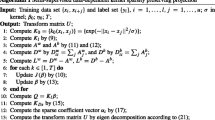Abstract
Dimensionality reduction methods have commonly been used as principled ways to understand high-dimensional data. In this paper, a novel non-linear method named supervised data-dependent kernel sparsity preserving projection (SDKSPP) is proposed for dimensionality reduction. SDKSPP is a non-linear extension of sparsity preserving projection, it adopts a data-dependent kernel (DK) instead of standard kernels to achieve performance improvements. Different from previous dimensionality reduction methods based on DK, SDKSPP can simultaneously optimize the coefficients in DK and explore the manifold structure, i.e., the sparse reconstructive relationship of data. The manifold structure in the feature space is shared in the label space so that the information of labels can be utilized to help optimizing the coefficients in DK and improving the discriminative ability. After the optimal sparse reconstructive relationship is obtained, a transform matrix that can preserve this relationship is calculated to project the mapped data into a low-dimensional space. The effectiveness of the proposed method is tested and compared on nine popular databases.












Similar content being viewed by others
References
Turk MA, Pentland AP (1991) Face recognition using eigenfaces. In: International conference on computer research and development, CVPR. IEEE, pp 302–306
Belhumeur PN, Hespanha JP, Kriengman DJ (1997) Eigenfaces vs. Fisherfaces: Recognition using class specific linear projection. IEEE Trans Pattern Anal Mach Intell 19(7):711–720
Tenenbaum JB, De SV, Langford JC (2000) A global geometric framework for nonlinear dimensionality reduction. Science 290(5500):2319
Roweis ST, Saul LK (2000) Nonlinear dimensionality reduction by locally linear embedding. Science 290 (5500):2323
Qiao L, Chen S, Tan X (2010) Sparsity preserving projections with applications to face recognition. Pattern Recogn 43(1):331– 341
Zhang J, Wang J, Cai X (2017) Sparse locality preserving discriminative projections for face recognition. Neurocomputing 260:321–330
Lou S, Zhao X, Chuang Y, Zhang S (2016) Graph Regularized Sparsity Discriminant Analysis for face recognition. Neurocomputing 173(P2):290–297
Zhang P, You X, Ou W, Chen CLP, Cheung YM (2016) Sparse discriminative multi-manifold embedding for one-sample face identification. Pattern Recogn 52(C):249–259
Gao S, Tsang WH, Chia LT (2010) Kernel Sparse Representation for Image Classification and Face Recognition. In: European Conference on Computer Vision, ECCV, pp 1–14
Lin C, Wang B, Zhao X, Pang M (2013) Optimizing kernel PCA using sparse representation-based classifier for MSTAR SAR image target recognition. Mathematical Problems in Engineering 2013(6)707–724
Lee MMS, Keerthi SS, Ong CJ, Decoste D (2004) An efficient method for computing leave-one-out error in support vector machines with Gaussian kernels. IEEE Trans Neural Netw 15(3):750–757
Cristianini N, Kandola J, Elisseeff A, Shawe-Taylor J (2002) On Kernel-Target alignment. Adv Neural Inform Process Syst 179(5):367–373
Lanckriet GRG, Cristianini N, Bartlett P, Ghaoui LE, Jordan MI (2004) Learning the kernel matrix with Semi-Definite programming. J Mach Learn Res 5(Jan):27–72
Ong CS, Smola AJ, Williamson RC (2005) Learning the kernel with hyperkernels. J Mach Learn Res 6 (1):1043–1071
Amari S, Wu S (1999) Improving support vector machine classifiers by modifying kernel functions. Neural Netw 12(6):783–789
Xiong H, Zhang Y, Chen XW (2007) Data-Dependent Kernel machines for microarray data classification. IEEE/ACM Trans Comput Biol Bioinform 4(4):583–595
Xiong H, Swamy MN, Ahmad MO (2005) Optimizing the kernel in the empirical feature space. IEEE Trans Neural Netw 16(2):460–474
Luo L, Bao S, Mao J, Tang D (2016) Nonlinear process monitoring based on kernel global-local preserving projections. J Process Control 38:11–21
He Z, Li J (2015) Multiple data-dependent kernel for classification of hyperspectral images. Expert Syst Appl 42(3):1118–1135
Motai Y, Yoshida H (2013) Principal composite kernel feature analysis: Data-dependent kernel approach. IEEE Trans Knowl Data Eng 25(8):1863–1875
Li JB, Wang YH, Chu SC, Roddick JF (2014) Kernel self-optimization learning for kernel-based feature extraction and recognition. Inf Sci 257(2):70–80
Gu N, Wang D, Fan M, Meng D (2014) A kernel-based sparsity preserving method for semi-supervised classification. Neurocomputing 139:345–356
Hou P, Geng X, Zhang ML (2016) Multi-Label Manifold Learning. In: Thirtieth AAAI Conference on Artificial Intelligence, AAAI, pp 1680–1686
Smola AJ, Schölkopf B, Müller KR (1998) The connection between regularization operators and support vector kernels. Neural Netw 11(4):637–649
Wang D, Zhang M, Cai Z et al (2016) Combatting nonlinear phase noise in coherent optical systems with an optimized decision processor based on machine learning. Opt Commun 369:199–208
Grant M, Boyd S (2008) Graph implementations for nonsmooth convex programs. Lect Notes Control Inf Sci 371:95–110
Wen J, Fang X, Cui J et al (2018) Robust sparse linear discriminant analysis. IEEE Trans Circ Syst Video Technol PP(99):1–13
Martínez A M, Kak AC (2001) PCA versus LDA. IEEE Trans Pattern Anal Mach Intell 23(2):228–233
Samaria FS, Harter AC (1994) Parameterisation of a stochastic model for human face identification. In: Proceedings of the Second IEEE Workshop on Applications of Computer Vision. IEEE, pp 138–142
Georghiades A, Belhumeur PN, Kriegman DJ (1997) Yale face database, Center for computational Vision and Control at Yale University, http://cvc.yale.edu/projects/yalefaces/yalefaces.html
Hull JJ (1998) A database for handwritten text recognition research. IEEE Trans Pattern Anal Mach Intell 16(5):550–554
LeCun Y, Bottou L, Bengio Y, Haffner P (1998) Gradient-based learning applied to document recognition. Proc IEEE 86(11):2278–2324
Yuan S, Mao X, Chen L (2018) Sparsity regularization discriminant projection for feature extraction. Neural Processing Letters. https://doi.org/10.1007/s11063-018-9842-4
Zheng J, Qiu H, Wang W et al (2016) Kernel-based discriminative elastic embedding algorithm. Appl Intell 44(2):449–456
Luo T, Yang Y, Yi D et al (2017) Robust discriminative feature learning with calibrated data reconstruction and sparse low-rank model. Applied Intelligence. https://doi.org/10.1007/s10489-017-1060-7
Wright J, Yang A, Sastry S, Ma Y (2009) Robust face recognition via sparse representation. IEEE Trans Pattern Anal Mach Intell 31(2):210–227
Acknowledgments
This work is partially supported by the National Natural Science Foundation of China (No. 61573088, No. 61573087 and No. 61433004).
Author information
Authors and Affiliations
Corresponding author
Rights and permissions
About this article
Cite this article
Zhang, A., Gao, X. Supervised data-dependent kernel sparsity preserving projection for image recognition. Appl Intell 48, 4923–4936 (2018). https://doi.org/10.1007/s10489-018-1249-4
Published:
Issue Date:
DOI: https://doi.org/10.1007/s10489-018-1249-4




